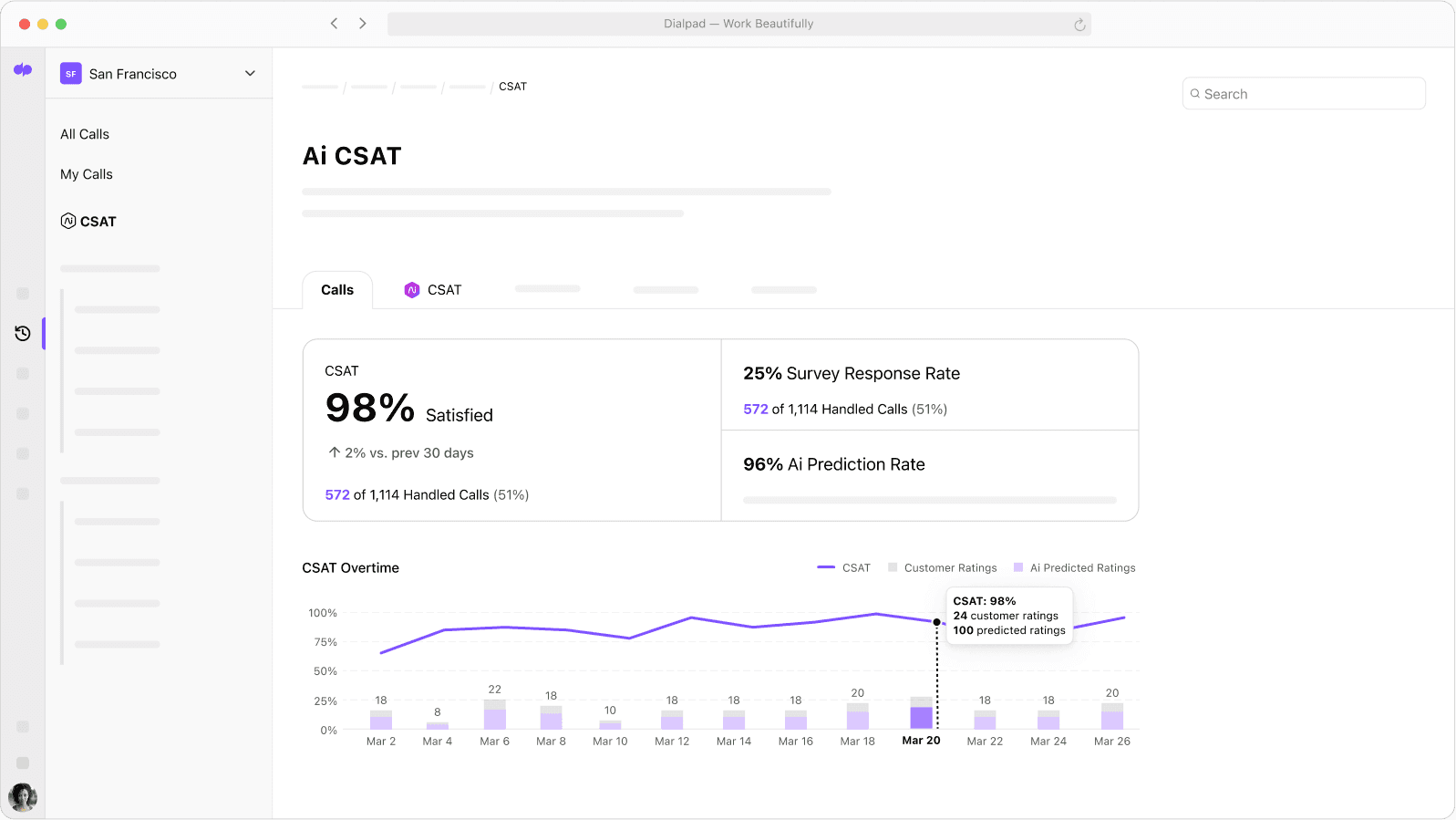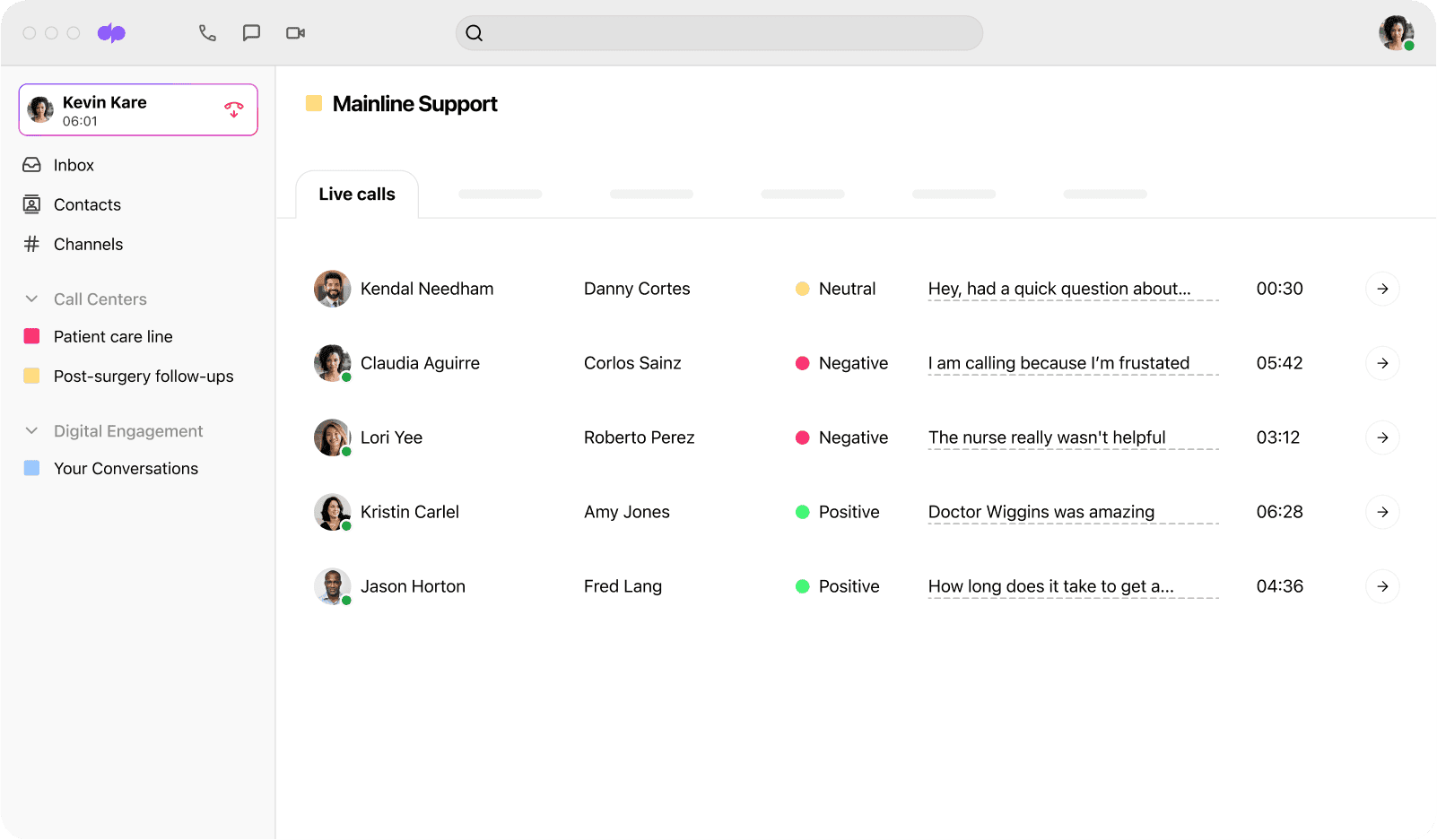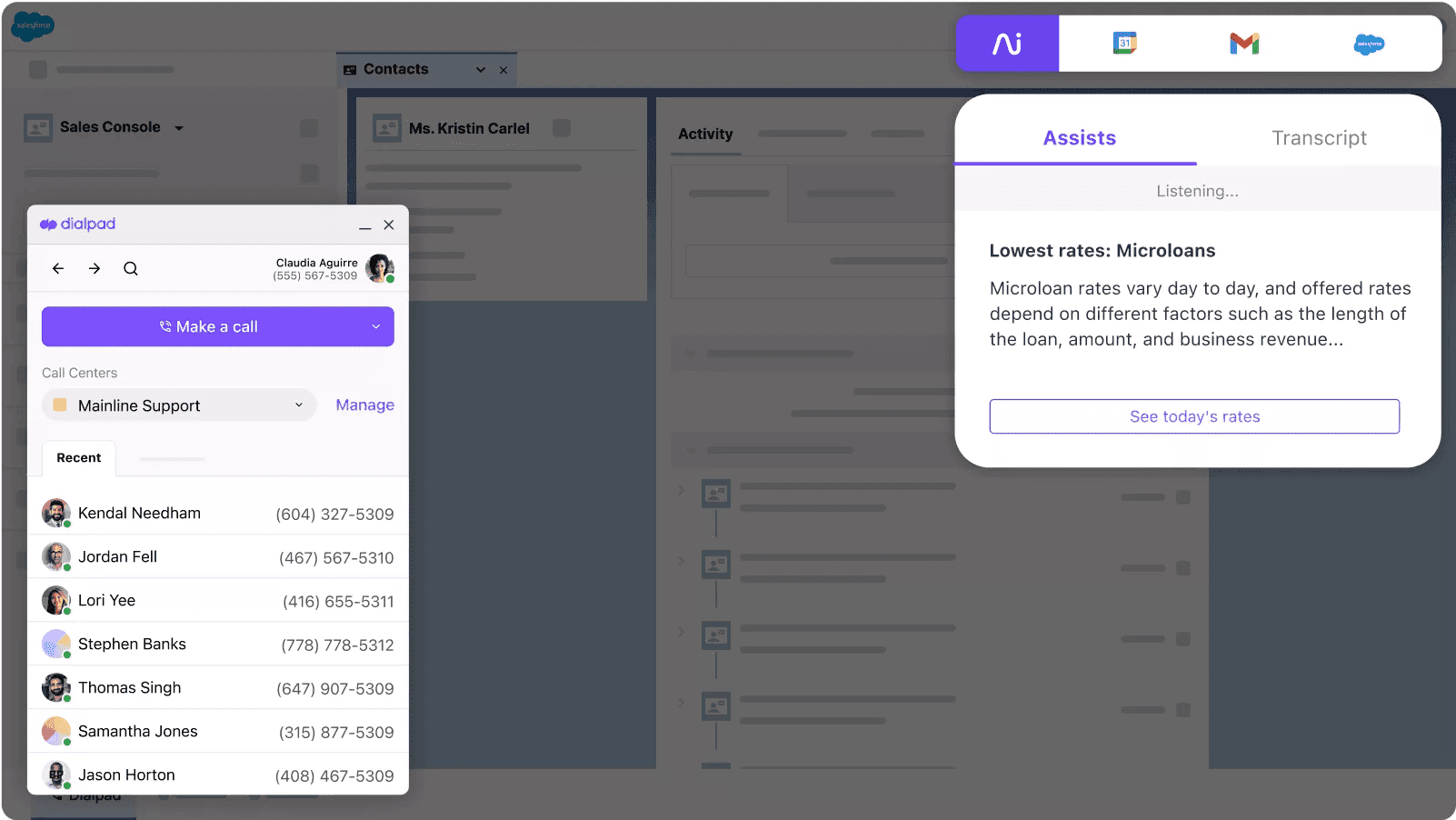Conversational AI for customer service: What is it and how should you use it?

Customer Support Manager - Tier 1

Tags
Share
AI is on everyone’s mind right now, and not just because it’s fun playing with different prompts and seeing what ChatGPT and Bard respond with.
And specifically, conversational AI is something that most folks who work in marketing, sales, and customer service are seeing more and more of every day.
Even though it’s still early days in the generative AI world, it’s already clear that conversational AI can help businesses improve their customer service and empower agents and supervisors to work more productively—just to name a few use cases.
Working in customer support at an AI company, I’m lucky to be able to be using an industry-leading conversational AI platform and to have a front-row seat for truly cutting-edge AI advancements that are designed to help both contact center agents and supervisors.
In this blog post, we’ll explore how conversational AI can be used for customer service, and get a sneak peek at what a good conversational AI platform can do for your support team.
But first, let’s answer an important question.
What is conversational AI? A quick overview
Conversational AI is a type of artificial intelligence technology that uses natural language processing (NLP) and machine learning algorithms to recognize, interpret, and respond to customer inquiries in real-time businesses to automate their customer service operations and provide a more personalized customer experience. It uses natural language processing (NLP) and machine learning algorithms to interpret and respond to questions or prompts in real-time.
You’ve probably come across conversational AI before—companies often use it to automate routine tasks like answering customer questions on their websites or digital channels (like WhatsApp):

The technology behind conversational AI
Depending on the conversational AI platform being used and how sophisticated its NLP technology is, you may notice differences in how natural or friendly the AI’s responses are, how accurately it can respond to a variety of questions, and how well it understands the questions that are being asked.
📚 Further reading:
Learn more about NLP in customer service.
This element is key: Traditional customer service chatbots require someone to pre-populate questions and manually map those questions to answers (like how you would create a multiple choice test.)
It's hard to describe how challenging that is—not only do they have to write out the answers, but the chatbot manager must think of every phrase that triggers a response, and the specific way a customer might ask these questions. From there, the manager then has to constantly triage the chatbot to understand missed answers, phrases, and keywords that aren't included, and add those in. It's incredibly challenging and time-consuming.
For example, in the screenshot above, you can see that the customer ignored the preset options and put in a pretty low-effort prompt that wasn’t even a question (“I want to move my Internet”). The conversational AI could still understand this, and responded in a natural-sounding way—and more importantly, gave the response that the customer needed.
This quick example shows the importance of a few elements within a conversational AI platform:
You need NLP, because without natural language processing, the answers that your AI gives won’t sound natural or friendly
You also need generative AI, which “generates” these answers or outputs
You also need good datasets because your AI platform learns from these datasets. For example, if you work at a car dealership, would you want your AI tool to be trained on all the data available on the internet including everything on Reddit and Wikipedia—or do you want it to be trained on datasets that are specifically about buying, selling, and fixing vehicles?
What are some common applications for conversational AI in customer service?
In the contact center industry, there are two big customer service use cases for conversational AI right now.
Virtual agents
Think of virtual agents or AI virtual assistants as super-advanced chatbots. This is one of the most popular ways that conversational AI is already being used in customer service—to interact with customers directly and help them troubleshoot issues.
In Dialpad Ai Contact Center, for example, we can put together a conversational AI flow in just a few clicks with the no-code drag-and-drop builder:

A conversational AI-powered virtual agent can handle a wide variety of questions about product information, pricing, order status, and more. Not only does this help customers self-service on their own schedule (even outside your regular business hours), it can also help reduce high call volumes and the burden on your human agents.
A couple important notes here: The most successful implementations of conversational AI are typically successful because the system has been trained specifically on the topics related to the business’s unique products or services. This is something to keep in mind when you’re considering which LLMs (large language models) to use with your AI tools.
Equally important is the internal or external knowledge sources that your conversational AI pulls from. Many conversational AI technologies require complex mapping of subject matters to content repositories. If you have a sophisticated enough conversational AI (*ahem* Dialpad) you can bypass this step by connecting the conversational AI directly to either internal or external knowledge sources. The AI can then both infer the context of the question being asked and map the appropriate response based on the connected knowledge, saving your teams a ton of time and effort.
Agent guidance
One not-so surprising fact about contact center agents is that they’re constantly searching for information—whether it’s customer information from a CRM, product details, pricing sheet, or process documentation, the average agent wastes a tremendous amount of time switching through dozens of repositories and chrome tabs.
The other big customer service use case for conversational AI is on the agent side—similar to how customers can get answers to their questions in natural language, agents can immediately access crucial information in order to speed up customer interactions.
Dialpad’s Ai Agent Assist, for instance, does exactly this:

This way, contact center agents can easily get the information they need to successfully resolve issues for customers without filtering through 15 web browser tabs.
Next, let’s look at the benefits of using conversational AI for customer service in these two ways.
Key benefits of conversational AI in customer service
We’ve barely scratched the surface of different ways in which support teams can use conversational AI, but there are three key benefits that we already have both anecdotal and quantitative evidence for.
A better customer experience
One of the most touted benefits of conversational AI is, of course, the ability to give your customers more avenues to solve problems on their own, and ultimately an improvement in the customer experience.
If you want to look at it in terms of metrics, having these AI self-service tools to answer questions helps businesses reduce wait times for customers and get to resolutions more quickly.
Fun fact: According to a survey of customer care leaders from McKinsey, almost two-thirds of respondents who were able to decrease their call volumes said that “improved self-service” was a key driver:

Agent empowerment
Customer service teams that use conversational AI also benefit from having more empowered agents.
Conversational AI tools can give agents instant access to insights into their customers’ needs and helpful information so they can tailor their responses and provide more effective solutions faster.
💡 Did you know:
Dialpad Ai can search all connected knowledge sources—even unstructured sources like PDFs and past customer conversations—to find the information an agent needs, as they’re talking to the customer.
In fact, according to the State of AI in Customer Service Report, agents using Dialpad Ai can handle, on average, twice as many calls as those who don’t:

Increased efficiency and cost savings
You’ve probably heard some variation of this statement before: “By eliminating repetitive, low-value processes like manually entering data and responding to basic customer inquiries, companies can save X amount of time and money.”
Whether you’re getting your numbers from Gartner, Insider, Juniper Research, or any other analyst or research firm, the question isn’t about whether AI will help businesses save money anymore—it’s about how many billions of dollars they’ll save.
4 best practices when adding conversational AI to your customer service
1. Understand what your customers need
Before you start incorporating conversational AI into your customer service strategy, it’s important to first understand what your customers are looking for from you.
Are they waiting too long on hold to speak to someone? Do you have an FAQ page or online knowledge base where customers can find answers to common questions? Which issues are coming up the most frequently and causing customers to contact your customer service team?
These are all important questions that you should know the answers to before going shopping for a conversational AI tool.
Dialpad Ai actually is very helpful here—the “Custom Moments” feature lets us easily track how often different topics come up in customer calls. Say I want to see how often our customers are asking about refunds.
I can create a Custom Moment that tracks every time “refund” or “money back” is spoken on a call. This is a great sales AI tool as well—if you want to know which products or services your clients are most interested in, Dialpad Ai can track those mentions:

(With Ai Virtual Agent, we can gain access to a tremendous amount of intelligence about what customers are asking, including popular topics, whether they’re getting the answers they want to see, how often they need to escalate their request, and much more.
2. Have a robust knowledge base
Your knowledge base is your repository of information about all your products or services, and this is what your conversational AI solution will search during the troubleshooting process.
If your knowledge base is too basic, then your AI solution won’t be able to answer all the various types of questions that your customers may ask.
By taking the time to create a comprehensive knowledge base filled with information about frequently asked questions, product features, and even the edge cases, you can ensure that your contact center AI will be able to give customers quick answers without having to involve an agent or contact support team member.
And again, with Dialpad’s Ai Virtual Agent, developing a comprehensive knowledge base is as simple as connecting the AI to your internal and external repositories—this could mean connecting to a Google Drive, your website, an internal wiki, or a combination of different sources. The AI is able to understand customer intent and pull the most relevant information accordingly.
3. Use a conversational AI solution that’s trained for your industry or business
The data that a conversational AI solution is trained on is crucial. That’s a big reason why businesses can’t just use consumer-focused language models or tools like ChatGPT.
Imagine if you work in an insurance company and get questions from customers about policies and coverages. You have to be sure that your conversational AI is providing the right answers!
📚 Further reading:
Learn more about AI transcription accuracy and why it matters when you’re looking at using AI tools for work.
4 . Monitor performance regularly
Last but not least , track your performance and metrics associated with conversations handled by your conversational AI or chat bot. This will give you a better understanding of which types of AI-supported requests generate positive outcomes for both customers as well as agents .
Dialpad, for example, has a pretty robust contact center analytics dashboard that shows us all our KPIs like missed and abandoned calls, average speed to answer, and even CSAT scores (inferred by Dialpad Ai!):

What to look for in a conversational AI platform for customer service
When you’re choosing a conversational AI platform for customer service agents and supervisors, there are several factors to consider.
The data sets that it’s trained on
It’s important that your AI platform’s machine learning algorithms can help it to continuously learn from past experiences and improve its performance over time.
This will help your system identify patterns in customer interactions, stay up to date with changes in your industry or products, and adapt its responses accordingly so it can provide better results faster.
How secure is it?
This is an ever-evolving subject when it comes to AI, but security should be top of mind for any business that’s looking to incorporate AI in the workplace—especially if your customer service team will be using AI while handling sensitive customer information. (Learn more about contact center compliance and how Dialpad Ai Contact Center is built with security as a top priority.)
Integrations with your tech stack
One of the best things about using Dialpad Ai Contact Center is that all of that incredible AI call center functionality is built right into the communications solution that our team uses to have phone calls, host video meetings, and send messages:

We don’t have to toggle between AI transcription, video calling, or instant messaging apps—it’s all in one place.
This consolidates all those different conversations into one place and makes life a lot easier for both agents and supervisors (and is easier for IT teams to admin too since they don’t have to juggle five or six different pieces of software).
In terms of other business tools like Salesforce and HubSpot, Dialpad does also have a great library of integrations.
The Salesforce integration, for example, injects Dialpad’s Ai Agent Assist feature right into the CRM, which means agents can get those helpful call pops without leaving Salesforce:

How will you use conversational AI for customer service?
If your support team isn’t already using conversational AI, there’s no time like the present.
Whether you’ve got new agents who need a little extra help on the call, or low CSAT scores because customers are waiting too long on hold, a good conversational AI solution can empower your agents and provide cost savings—along with giving you a competitive advantage in terms of your customer experience.
See how you can achieve this with Dialpad Ai Contact Center!
Get a hands-on look at the industry-leading AI contact center
Book a demo with our team, or take a self-guided interactive tour of the app first!








